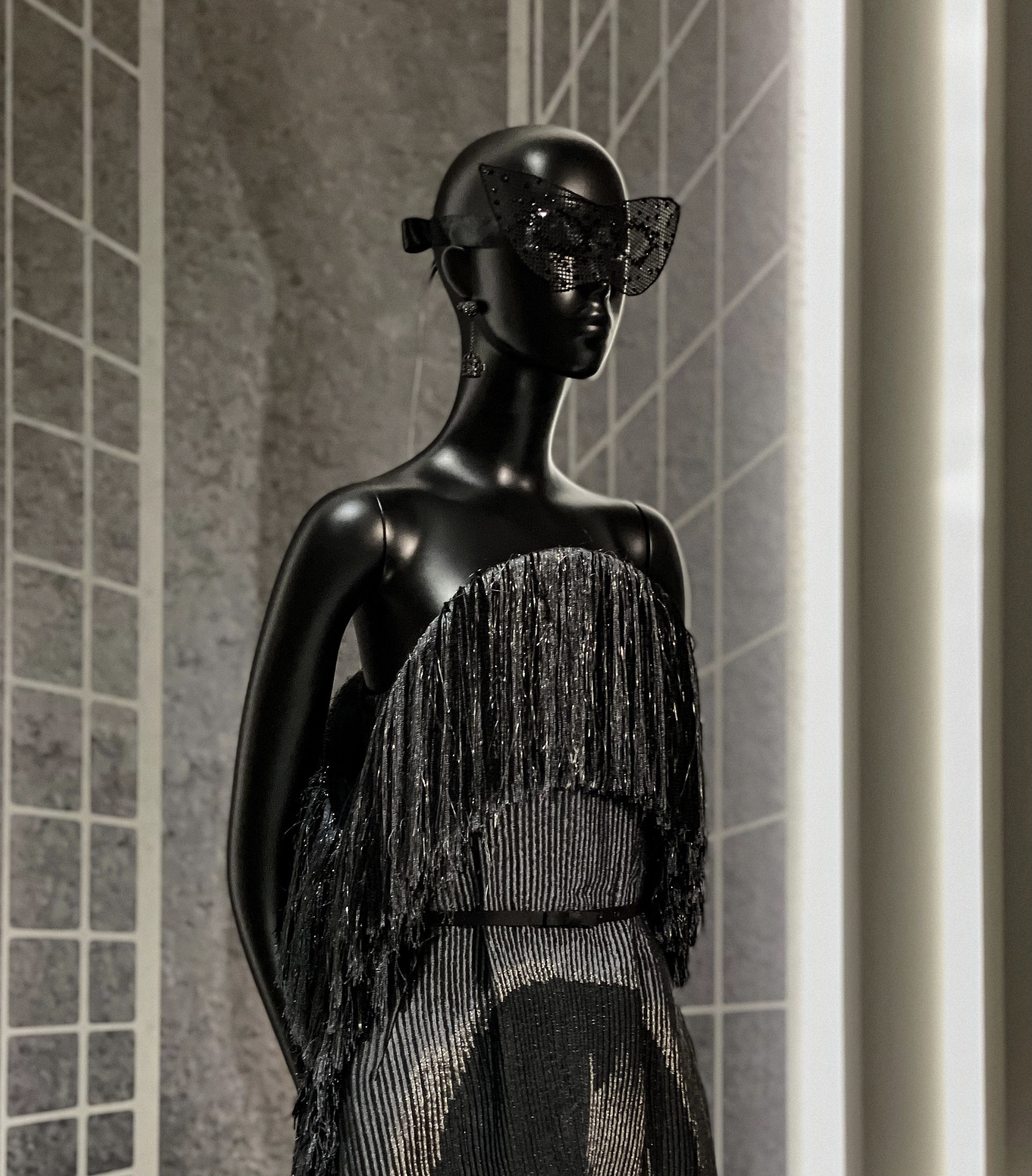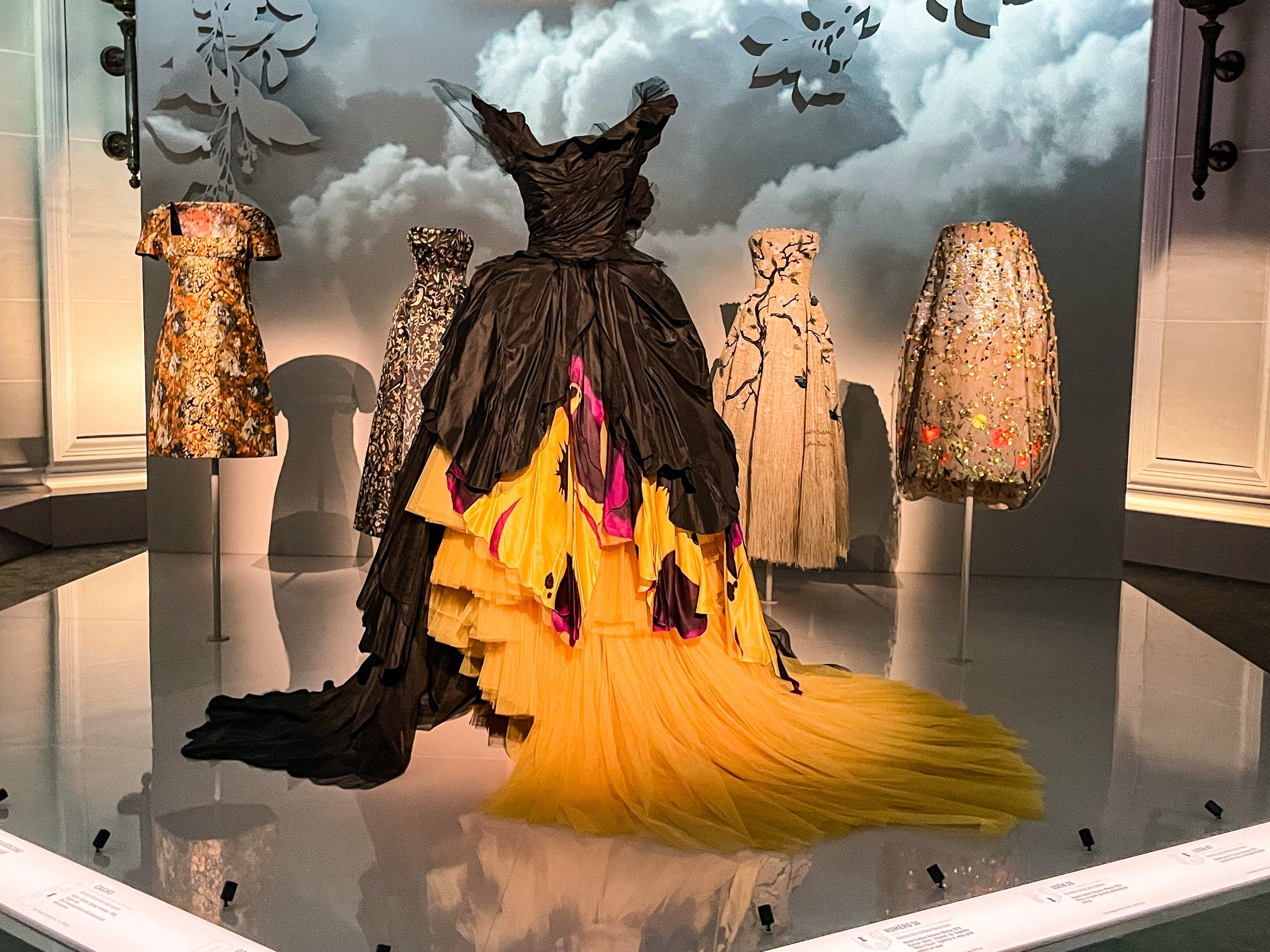NEW YORK CITY LOVES JAPANESE ART
Explore the Japanese art that is gracing the showrooms of New York City’s contemporary art galleries.
Read MoreExplore the Japanese art that is gracing the showrooms of New York City’s contemporary art galleries.
Read MoreExplore the intriguing imaginative art of Ob
Read More
I am a thoroughly modern girl who loves minimalist design. My fashion tastes run towards the understated as well. But I know to give credit where credit is due, and the current “Christian Dior: Designer of Dreams” show at the Brooklyn Art Museum certainly deserves it. It is, as the title of this post suggests, dreamy.

“My dresses make a princess out of every woman.” — Christian Dior
The show which opened at The Brooklyn Art Museum in early September and runs through February traces the 70+-year history of the House of Dior through a brilliant experiential extravaganza full of gowns, videos, photos, sketches and accessories.
Upon entry, you’re treated to the early days of Dior. Larger-than life illustrations, 1950s dresses and suits, newspaper clippings commemorating the opening of the designer’s first New York City outpost at 730 Fifth Avenue. Weaving through the early designs, I was struck by how timeless and imminently wearable the “high fashion” was at the time. It’s not that difficult to imagine picking an outfit or two and trying them on, even today.
Next stop on the journey made the photography lover in me jump for joy. The curators have compiled an outstanding collection of Dior’s advertising campaign photographs. A veritable who’s who of fashion photography, including Lillian Bassman, Louise Dahl-Wolfe, Arthur Elgort, Horst P. Horst, William Klein, David LaChapelle, Annie Leibovitz, Gordon Parks, Irving Penn, Herb Ritts, Cass Bird and Tyler Mitchell. And the arrangements are amazing. Richard Avedon’s iconic “Dovima With Elephants, Evening Dress by Dior” photograph from 1955 is set against the actual Dior haute couture gown it pictures. Another iconic photograph, Bert Stern’s Marilyn Monroe’s 1962 “The Last Sitting” is just a few steps away.
But all of this is just the appetizer preparing you for the main course that is the “promenade” of sorts that walks you through the brand’s history, one creative director at a time. Step by step, you are here to discover the personalities, the colors, the detail, the focus. From the relatively simple “New Look” of the early years, the architecturally refined pieces by Gianfranco Ferrè that followed, to the fantastical over-the-top creations by John Galliano, the modernity of Raf Simons and finally, to Maria Grazia Chiuri who, as the first female creative director in the history of the brand, is both bringing the brand back to its more classical roots while also infusing it with a bit of feminism.

Just when you feel you’ve seen it all, the curators pull another rabbit out of the hat. Welcome to the “Enchanted garden.”
The museum’s 10,000-square-foot Beaux-Arts Court has been transformed into an enchanted garden filled with spectacular embroidered and flower-covered dresses that surround you at every step. Some line up in several “catwalks”. Others assemble in trios that “guard” the corners of the court. And many others encourage you to tilt your head up in admiration, as gown after gown have been arranged vertically all the way to the ceiling in one dizzying display after another. With clouds and flowers projected onto the background and subtle music playing around you, the garden steals your heart and helps you lose yourself in the feeling.
Delighted by your garden experience, you might be floating on cloud nine. But, Monsieur Dior is not done with you yet. For his “adieu”, he’s got one more trick up his sleeve. Dresses that were seen the world over, worn by the most talented actresses at the pinnacle of their acting careers and being recognized for their art. So take a breath, and walk through this last award ceremony gown hall. Only then you will feel you’ve completed the mission and can return to the reality. Merci, et au revoir, Monsieur Dior!


New York City. Hustle and bustle. Traffic. Honking cars. Pedestrians rushing by. A concrete jungle that can swallow you whole.
But what if you could use all that concrete to help you pause? Take a breath. Slow down and let yourself drift away for a few fleeting moments. With The Drift, the show currently running at The Shed, you can.

The Drifters are, without a doubt, the main attraction in Studio DRIFT’s art installation currently on display at The Shed in New York’s Hudson Yards. The giant concrete blocks that float effortlessly through the air have been intriguing audiences ever since the Pace Gallery brought one to the Armory Show in 2017.
Designed to float and move at slow speed on a controlled three-dimensional path, The Drifters are meant to provoke thought. The studio founders Lonneke Gordijn and Ralph Nauta put it perfectly: “On its own the concrete block is nothing, lost in space and time without reference to anything; it is always searching to be part of something bigger. Drifter wants to make people feel that without context they are lost. Without context, the object feels alien, divorced from its source. Drifter shows how unknown the world and its mechanisms still are to mankind and emphasizes the urge to expand our horizon and evolve in time.”

And they do just that at the Shed. Once you’ve made your way through the other parts of the show (more on those later), you'‘re asked to pause briefly in the waiting room. Here you’re treated to a couple of short films: one showing The Drifters levitate across the world, making their way over verdant highlands, weaving through forests and reflecting in the rushing water of mountain streams below. The other movie hits closer to home: The Drifters navigate the air above Manhattan’s busy streets. Now you’re primed for the “performance.”
The curtain lifts and you make your way into the massive space with several Drifters hovering in a perfect line above your head. Some people sit down, others stretch out on the concrete floors. Lights dim, music starts and The Drifters above you start moving. A forward slide here, a spin there, coming closer and closer until you feel you can touch them, only to have them pull away just out of reach. It’s mesmerizing and it takes some discipline to put the camera away and just enjoy the moment. I loved it.

The Drifters are the main draw, but visitors would miss out if they did not stop in the room that showcases another Studio Drift installation, Ego. Introduced in 2020, “Ego” is a kinetic sculpture made out of translucent mesh fabric that morphs, inflates, floats, stretches and collapses, only to lift up again a few moments later. The founders see it as a representation of our hopes, truths and emotions that evolve along with our own mind. Linger, ponder and see how your own belief system works. Is it rigid, or is it fluid?
The Drift is on display at The Shed in New York City through December 19.
Studio DRIFT was founded by Dutch artists Lonneke Gordijn and Ralph Nauta in 2007. Based in The Netherlands, the team focuses on creation of experiential sculptures, installations and performances, combining hidden properties of nature and technology to help humans re-establish their connection to the Earth. Their work has been shown at Victoria & Albert Museum; Met Museum; Stedelijk Museum; Biennale di Venezia; Pace Gallery; and now at The Shed in New York City.

Reka Nyari: Effect Papillon
Those who know me, know my love of photography and portraiture. My admiration for those who look into the viewfinder and find the perfect moment, the perfect pose, the perfect silhouette and capture it for all of us to enjoy is a well established fact.
What many of my friends would not expect is an article where tattoos play a rather prominent role. If you asked me, I would not expect that, either! But then you come across an example of this body art in its most elevated, beautiful form and you make an exception. Reka Nyari is one of the artists whose work fits into this exceptional category.
How does one go from Finland and Hungary to spectacular ink photography? In Reka’s case the road goes through The School of Visual Arts and modeling. From there, it was just a quick step from the front of the camera behind the lens. From then, it’s and onwards to fashion, fine art photography and videography.
With the works of David Lynch, Helmut Newton, Miles Aldridge and Cindy Sherman as inspiration for her own work, Reka quickly developed a stunning photographic language of her own. Her striking black and white portraits of women often challenge the traditional ideals of beauty by bringing in extensive body decor while her posing of the model elevates the idea and remains captivating. Yes, there is nudity, but it almost feels like a side effect, not the main feature.
Those who want to only dip their toes into Reka’s fascinating world should take a peek at her stunning monograph, “Femme Fatale: Female Erotic Photography”.
According to the artist, this series creates an interesting juxtaposition - the symbolism of the Japanese geisha and the Yakuski, Japanese gangster, tattoos, Irezumju. Known for the painful process required to get this type of tattoos, they are seen as a symbol of the recipient’s bravery - but also their insubordination. Not what you’d associate with the the much calmer image of a geisha.
The latest series of this artist (and probably my favorite series from her work to-date) takes the idea of tattoos even further. Here, Reka takes the large scale portraits and makes them one-of-a-kind by “tattooing” each one - perforating patterns into the photographic prints. The result is a beautiful contrast: bold tattoos presented with distinctly feminine poses and enveloped by dreamy greenery and delicate botanical patterns, swirls and circles. Destruction, made beautiful. Or as the artist calls it, “ink, cubed.” I absolutely loved it.
The Reka Nyari show is on at the Fremin Gallery in Chelsea and it closes soon. Do yourselves a favor and go see it.

Reka Nyari: Lune de Sang